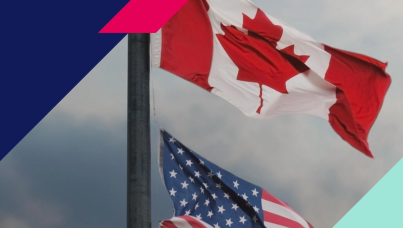Into The Election Window: Part 1
Further, in a seat range projection model exclusively prepared by Ipsos-Reid for CTV and The Globe and Mail it would appear that the federal Liberals would achieve a majority government if an election were held today; however, voters remain volatile in major regions of the country and this dynamic is fluid.
Liberals In Majority Territory If Vote Held Today, But Voter Dynamic Volatile And Minority Lurks...
If a vote were held today, the seat range projection model indicates the federal Liberals have a potential 171-175 seats while the Conservatives have a potential 64-68 seats, and the NDP has potential 10-14 seats. In the province of Quebec, the Bloc Quebecois has a potential of 55-59 seats. For a majority government at least 155 seats must be won. However, as indicated above, the electoral landscape remains volatile and the potential for either a majority or minority government is in flux and subject to the campaign that may ensue shortly.
These are the findings of an Ipsos-Reid/CTV/Globe and Mail poll conducted between May 11th and 17th, 2004. For the telephone survey, a representative randomly selected sample of 2000 adult Canadians was interviewed by telephone. With a sample of this size, the results are considered accurate to within 177 2.2 percentage points, 19 times out of 20, of what they would have been had the entire adult Canadian population been polled. The margin of error will be larger within regions and for other sub-groupings of the survey population. These data were weighted to ensure the sample's regional and age/sex composition reflects that of the actual Canadian population according to the 2001 Census data.
Overall Vote Stable Since Last Poll: Liberals (39%), Conservatives (26%), NDP (15%), Bloc (48% In Quebec vs. 28% Liberals), Green Party (5%)
Nationally, the Liberals hold 39% of the decided vote (down 1 point) with the Conservatives holding 26% of decided voter support (up 2 points) and the NDP attracting 15% support (unchanged). The Bloc Quebecois (48%, up 2 points) have grown their lead in Quebec to 20 points over the Liberals (28%, down 3 points).
Meanwhile, 5% (unchanged) of Canadians would cast their vote for the Green Party, and 3% would vote for some "other" party. Among all Canadians, a total of 7% (down 5 points) are undecided or don't know who they would vote for if a federal election were held tomorrow.
- In Ontario, the Liberals lead with 49% support (unchanged), with the Conservatives following at 27% (up 1 point), with the NDP trailing at 17% (up 1 point).
- In Quebec, the Bloc Quebecois (48%, up 2 points) has widened its lead to 20 points over the Liberals (28%, down 3 points), as the Conservatives remain static with approximately one in ten voters' support, and the NDP trail with 6%.
- In Atlantic Canada, the Liberals hold the lead with 49% of the decided vote (up 1 point from 48%) with the Conservatives following with 29% (up 1 point) and the NDP within range of the Conservatives with approximately 1 in 5 voters.
- In British Columbia, the Liberals lead in a tight three-way race with 33% (down 4 points), followed by the Conservatives at 31% (up 8 points) and the NDP at 27% (unchanged). Currently, the Green Party garners the support of approximately one in ten decided voters in British Columbia.
- In Alberta, the Conservatives remain stable at 50% support (down 1 point) with the Liberals at 31% support (up 2 points). The NDP currently has the support of approximately one in ten decided voters with the Green Party garnering the support of approximately one in twenty.
- In Saskatchewan/Manitoba the Liberals lead with 38% (up 1 point), with the Conservatives following at 33% (up 2 points). The NDP currently has the support of approximately one in five decided voters.
But, As For Momentum Over The Past Few Weeks, Paul Martin Trails The Other Leaders Badly (-26), With Jack Layton (+9) And Stephen Harper (+8)With More Traction...
When Canadians are asked whether over the past few weeks their opinion of each of the party leaders has improved, worsened, or stayed the same, the gap score analysis (gap score is the proportion who say their opinion has worsened subtracted from the proportion who say their opinion has improved) shows that Jack Layton (+9, down 3 points from +12 on April 6-8) and Stephen Harper (+8, down 8 points from +16) still maintain relatively positive momentum heading into the upcoming election, while Prime Minister Paul Martin is sagging badly (-26, down 3 points from -23). Meanwhile, Gilles Duceppe does not seem to have momentum as he registers a gap score of -2.
- In Alberta (-36) Prime Minister Paul Martin's gap score is the largest in the country, followed by -29 in Quebec, -27 in British Columbia, -25 in Saskatchewan/Manitoba, -23 in Ontario, and -22 in Atlantic Canada.
- Prime Minister Martin's momentum is stable among Liberal voters (+2), and is lowest among Conservative (-51) voters.
- Stephen Harper's momentum reaches a high in Quebec (+13), followed by Alberta (+10), Ontario (+7), British Columbia (+5), Atlantic Canada (+3), and Saskatchewan/Manitoba (zero).
- Stephen Harper has gained the most momentum among decided Conservative voters (+29), and he has lost some momentum amongst decided Liberal (-1) and NDP voters (-6).
- Jack Layton has the most momentum in British Columbia (+13), followed by Ontario (+12), Atlantic Canada (+8), Quebec (+6), Saskatchewan/Manitoba (+5), and Alberta (+2).
- Jack Layton has made the most positive gains in his impression among NDP voters (+28) followed by Liberal voters (+10), Bloc Quebecois voters (+8), and comes in stable with Conservative voters (+2).
- In the province of Quebec, the momentum for Gilles Duceppe is +12 (18% improved vs. 6% worsened) compared to Paul Martin who is at -29 (40% worsened vs. 11% improved).
- Bloc Quebecois voters give Gilles Duceppe the highest gap score (+25), while he has negative momentum with all other decided voters -- Liberal voters (-5), Green Party voters (-5), and Conservative voters (-4).
For explanation of the projected seat range model please visit:
http://www.ipsos-na.com/news/pressrelease.cfm?id=2197
Please open the attached PDF to view the factum and detailed tables.
For more information on this news release, please contact:
Darrell Bricker, Ph.D
President & C.O.O
Ipsos-Reid Public Affairs
(416) 324-2900



